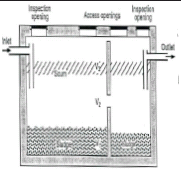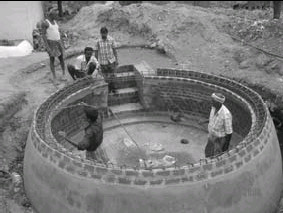<<< Previous
|
|
Next
> >>
|
| Technical Details (DEWATS) |
Environmental & Site considerations:
A DEWATS system should be be designed to suit specific environmental conditions, aswell as the kind of waste that one is dealingwith. The 'type of site condition' is taken into consideration while choosing the effluent disposal method. And the range of technology has already been developed for different conditions as shown below:
A DEWATS system should be be designed to suit specific environmental conditions, aswell as the kind of waste that one is dealingwith. The 'type of site condition' is taken into consideration while choosing the effluent disposal method. And the range of technology has already been developed for different conditions as shown below:
| Normal Site Conditions | Difficult Site Conditions | Adverse Site Conditions | |
| Subsoil Type | Suitable for percolation | Low permeability | Impervious |
| Water Table Depth | Deep | High | Very High |
| Bedrock | Unfractured | High and fractured | High and fractured |
| Ground Surface Slope | Favourable | Unfavourable | Steep |
| Flooding | None | Occasional | Frequent |
| Distance from water supply wells, buildings, escarpments | Far away | Close | Quite close |
| Lot size | Large | Small | Small |
| Disposal methods for septic tank effluent | Gravity flow over a conventional percolation trench or bed. | Further treatment needed Periodic dosing of a disposal field by pump or dosing syphon. | Drastic change water conservation, treatment and recycling. |
Design of septic tank:

| Settler / SepticTank: The settler is a sub soil constructed tank with one baffle wall. Within the
tank, two main treatment processes take place. First, a mechanical treatment
retains contaminants by sedimentation/ floatation and the waste water from
the clarified layer flows through the outlet. Through the digestion process the accumulated sludge is stabilized.
Storage volume for sludge is generally provided for 18 - 24 months
desludging interval.
Average reduction of [Biological Oxygen Demand]*[1] in the settler isbetween 20 and 25 %.The settlers can be integrated with the baffled reactor. |
Bio Gas Settler:
This serves as a sedimentation tank for retaining particles. The main treatment process is sedimentation and anaerobic digestion. As wastewater flows into a digester, the heavier solid particles settle down and anaerobic bacteria become active and start digesting organic material in the wastewater .
During digestion biogas is formed. The outlet is free from settle able
solids. Dissolved and suspended matter passes untreated to the next stage of
treatment. Efficiency 25% - 40%.
Desludging period 1 to 3 years depends on sludge storage. Biogas production - Gas storage is needed (gas tight)
|
Anaerobic Baffled Reactor
Biological Oxygen Demand : is
a measure of the oxygen used by microorganisms to decompose organic
waste in a water body. When organic matter such as dead plants,manure,
sewage, or even food waste is present in a water supply, the bacteria
will begin the process of breaking down this waste.When this
happens,much of the available dissolved oxygen is consumed by aerobic bacteria.
<<< Previous
|
|
Next
> >>
|
